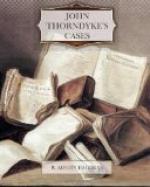“The larger particles,” said Thorndyke, with his eye applied to the microscope, “appear to be transparent, crystalline, and distinctly laminated in structure. It is not chalk, it is not whiting, it is not any kind of cement. What can it be?”
“Could it be any kind of shell?” I suggested. “For instance—”
“Of course!” he exclaimed, starting up; “you have hit it, Jervis, as you always do. It must be mother-of-pearl. Polton, give me a pearl shirt-button out of your oddments box.”
The button was duly produced by the thrifty Polton, dropped into an agate mortar, and speedily reduced to powder, a tiny pinch of which Thorndyke placed under the microscope.
“This powder,” said he, “is, naturally, much coarser than our specimen, but the identity of character is unmistakable. Jervis, you are a treasure. Just look at it.”
I glanced down the microscope, and then pulled out my watch. “Yes,” I said, “there is no doubt about it, I think; but I must be off. Anstey urged me to be in court by 11.30 at the latest.”
With infinite reluctance I collected my notes and papers and departed, leaving Thorndyke diligently copying addresses out of the Post Office Directory.
My business at the court detained me the whole of the day, and it was near upon dinner-time when I reached our chambers. Thorndyke had not yet come in, but he arrived half an hour later, tired and hungry, and not very communicative.
“What have I done?” he repeated, in answer to my inquiries. “I have walked miles of dirty pavement, and I have visited every pearl-shell cutter’s in London, with one exception, and I have not found what I was looking for. The one mother-of-pearl factory that remains, however, is the most likely, and I propose to look in there to-morrow morning. Meanwhile, we have completed our data, with Polton’s assistance. Here is a tracing of our friend’s skull taken from the mould; you see it is an extreme type of brachycephalic skull, and markedly unsymmetrical. Here is a transverse section of his hair, which is quite circular—unlike yours or mine, which would be oval. We have the mother-of-pearl dust from the outside of the hat, and from the inside similar dust mixed with various fibres and a few granules of rice starch. Those are our data.”
[Illustration: TRANSVERSE SECTIONS OF HUMAN HAIR: A, OF A NEGRO; B, OF AN ENGLISHMAN; C, OF THE BURGLAR. ALL MAGNIFIED 600 DIAMETERS.]
“Supposing the hat should not be that of the burglar after all?” I suggested.
“That would be annoying. But I think it is his, and I think I can guess at the nature of the art treasures that were stolen.”
“And you don’t intend to enlighten me?”
“My dear fellow,” he replied, “you have all the data. Enlighten yourself by the exercise of your own brilliant faculties. Don’t give way to mental indolence.”
I endeavoured, from the facts in my possession, to construct the personality of the mysterious burglar, and failed utterly; nor was I more successful in my endeavour to guess at the nature of the stolen property; and it was not until the following morning, when we had set out on our quest and were approaching Limehouse, that Thorndyke would revert to the subject.




